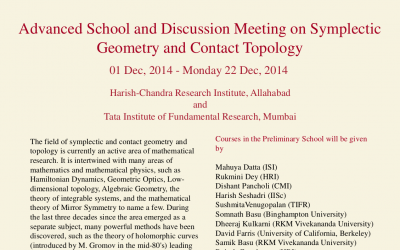The field of symplectic and contact geometry and topology is currently an active area of mathematical research. It is intertwined with many areas of mathematics and mathematical physics, such as Hamiltonian Dynamics, Geometric Optics, Low-dimensional topology, Algebraic Geometry, the theory of integrable systems, and the mathematical theory of Mirror Symmetry to name a few. During the last three decades since the area emerged as a separate subject, many powerful methods have been discovered, such as the theory of holomorphic curves (introduced by M. Gromov in the mid-80's) leading to the creation of Gromov-Witten theory and Floer homology in its different flavors. As a result, several outstanding problems in Hamiltonian Dynamics, e.g. Arnold's and Weinstein's conjectures were solved, and a link to Mirror Symmetry was found. These subjects will be the main focus of the present program.
The program is being organized in 3 parts:
- Preliminary school Dates: 01-13 December 2014 Venue: HRI, Allahabad
- Advanced school Dates: 15-19 December 2014 Venue: TIFR, Mumbai
- Discussion meeting Dates: 20-22 December 2014 Venue: TIFR, Mumbai
The preliminary school aims at bringing young faculty and postdocs up to gear. The resource persons for this component consist of relatively senior faculty in India who work in nearby areas. The courses will be easy-paced and assume only a general background in Geometry and Topology. The faculty responsible for these courses will be working out all details during the courses.
The advanced school will consist of a number of intensive mini-courses given by international experts. The aim is to expose the participants to these new developments in the area. We plan on having a maximum of 4 lectures a day to ensure that there is enough free time for discussions and clarifications, which should especially be useful for the younger participants.
The discussion meeting will consist of about 4 talks a day on recent results, with provision for enough time for discussions in between the talks. The hope is that this format will promote collaboration both within India and between Indian mathematicians and their colleagues from abroad.
 contactdec2014
contactdec2014  gmail
gmail com
com- Talks
- Other links


